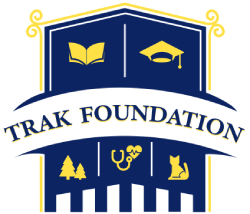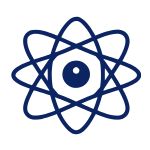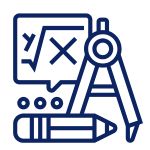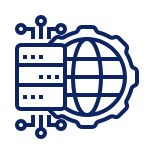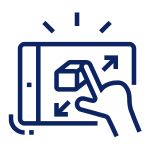STEM LAB by TRAK!
At TRAK, we’re passionate about fostering curiosity, sparking innovation, and nurturing the next generation of problem solvers and critical thinkers. Our state-of-the-art STEM Lab is a hub of creativity, exploration, and learning, where students of all ages can delve into the exciting world of science, technology, engineering, and mathematics
In TRAK STEM Lab, models are educational tools and representations, used to help students understand complex concepts, visualize scientific phenomena, and solve problems. Models come in various forms, depending on the specific focus of the lab and the level of education.
Here are some common types of models used in our STEM lab:
The choice of model depends on the educational objectives, the specific STEM field, and the level of students. Models are powerful tools for making abstract and complex concepts more accessible and engaging, helping students gain a deeper understanding of STEM subjects.
MATHEMATICS LAB by TRAK
At the Mathematics Lab, we’re dedicated to making mathematics not just a subject to study but an adventure to explore. Our state-of-the-art Mathematics Lab is a place where school students can transform their mathematical skills from mere numbers and equations into a thrilling journey of discovery and problem-solving.
In TRAK Mathematics Lab,, various models are being used to make mathematical concepts more tangible and easier to understand.
- Number Lines: Number lines are a visual representation of numbers arranged in order. They are helpful for teaching addition, subtraction, multiplication, division, and concepts like fractions and decimals.
- Geometric Shapes: Geometric models include various shapes, such as squares, triangles, circles, and polygons. These can be used to teach geometry, symmetry, and measurement.
- Base-ten Blocks: These are physical models that represent the base-ten system and are used to teach place value, addition, subtraction, multiplication, and division.
- Fraction Bars and Circles: Fraction models help students visualize and understand fractions, as well as concepts like equivalent fractions, adding and subtracting fractions, and comparing fractions.
- Pattern Blocks: Pattern blocks are colorful geometric shapes that can be combined to create patterns, explore symmetry, and teach concepts related to area and perimeter.
- Money Models: Coins and bills are used to teach concepts related to counting money, making change, and understanding the value of different denominations.
- Graph Paper: Graph paper is a valuable tool for teaching coordinate geometry, plotting points, and graphing functions.
- Cuisenaire Rods: These are manipulatives that help students understand number relationships, fractions, and mathematical operations.
- Algebra Tiles: Algebra tiles are used to introduce algebraic concepts such as equations, expressions, and factoring.
- Clocks and Time Models: Clocks with movable hands or digital models can be used to teach time-telling, time conversion, and understanding the concept of time intervals.
- Number Cubes and Dice: Number cubes and dice are used to teach probability, statistics, and concepts related to random events.
- Counters and Manipulatives: Small objects like beans, buttons, or plastic chips can be used for various counting and problem-solving activities.
- Pattern and Sequence Models: Pattern cards and sequence models can be used to teach mathematical patterns and number sequences.
- Place Value Charts: These charts help students understand the relationship between digits in numbers and the concept of place value.
- Equation Balances: Equation balances are models used to represent equations and help students visualize and solve algebraic equations.
These models are designed to engage students, promote hands-on learning, and make mathematical concepts more concrete and relatable. They are being used to teach a wide range of mathematical topics in a way that appeals to different learning styles and abilities.
ELECTRONICS LAB by TRAK
At Electronics Lab, we’re dedicated to sparking innovation, nurturing creativity, and fostering a deep understanding of electronics. Our cutting-edge Electronics Lab is a hub of exploration, discovery, and hands-on learning for enthusiasts, hobbyists, and professionals alike.
- What We Offer:
- Hands-On Learning: Our Electronics Lab provides an interactive and immersive experience for individuals looking to explore the world of electronics. From building circuits to designing and programming electronic projects, we offer a wide range of activities that make learning both engaging and enjoyable.
- Expert Guidance: Our team of experienced electronics enthusiasts and professionals are here to assist and inspire. They provide expert guidance, ensuring that participants receive the support and knowledge needed to excel in electronics.
- Advanced Equipment: Equipped with state-of-the-art electronic components, tools, and testing equipment, our lab ensures that participants have access to the best resources for their electronic projects, experiments, and prototyping.
- Collaborative Environment: Collaboration and knowledge-sharing are at the heart of our lab. Participants work together on projects, exchange ideas, and learn from one another, creating a vibrant and supportive community.
Why Choose Electronics Lab :
- Innovation: We believe that electronics are at the core of technological innovation. Our lab aims to inspire the next generation of innovators who will shape the future through electronic advancements.
- Diversity and Inclusivity: We welcome individuals of all skill levels, backgrounds, and ages to participate in our programs. Our goal is to make electronics accessible to everyone.
- Practical Skills: Our programs emphasize hands-on experience, providing participants with practical skills that are valuable in various fields, from engineering to DIY projects.
TINKERING Lab by TRAK
At TRAK Tinkering Lab, we believe in the power of curiosity, creativity, and hands-on exploration. Our Tinkering Lab is a dynamic space where individuals of all ages can dive into the world of making, designing, and problem-solving. Whether you’re a budding inventor, a seasoned maker, or just someone looking to learn something new, our lab has something exciting to offer.
What We Offer:
- Creative Workspaces: Our Tinkering Lab features a variety of creative workspaces equipped with tools, materials, and resources for making, designing, and experimenting. From 3D printers to woodworking tools, we’ve got it all.
- Experienced Mentors: Our team of experienced mentors and facilitators are here to guide, inspire, and assist you in bringing your ideas to life. They’re passionate about nurturing creativity and supporting your tinkering journey.
- Open-Ended Projects: We encourage open-ended exploration and creativity. Our lab is a place where you can dream, design, and build without limits. We provide a wide range of project ideas or the freedom to pursue your own innovative concepts.
- Community Collaboration: Collaboration is at the heart of our lab. Share ideas, insights, and knowledge with fellow tinkerers, fostering a vibrant and supportive community of makers.
Why Choose TRAK Tinkering Lab:
- Empowerment: We believe that everyone has the potential to be a creator and an inventor. Our lab aims to empower individuals to turn their ideas into reality.
- Skill Building: Tinkering is not just fun; it’s an opportunity to build essential skills in problem-solving, critical thinking, and innovation.
- Inclusivity: Our Tinkering Lab welcomes people of all backgrounds, ages, and skill levels. We aim to make hands-on learning accessible to all.
Astronomy Labs by TRAK
At TRAK Astronomy Lab,, we invite you to embark on a celestial journey, explore the mysteries of the universe, and unlock the wonders of the night sky. Our Astronomy Lab is a window to the cosmos, where individuals of all ages can unravel the secrets of the stars, planets, and beyond.
What We Offer:
- Observation Equipment: Our Astronomy Lab is equipped with state-of-the-art telescopes, binoculars, and observation tools that provide an up-close view of celestial objects, from distant galaxies to our neighboring planets.
- Expert Guidance: Our team of knowledgeable astronomers and stargazers are here to guide and enlighten you. They are passionate about sharing their astronomical expertise and assisting you in your celestial exploration.
- Starry Workshops: We offer a range of workshops and courses that cover topics such as stargazing, astrophotography, and understanding the night sky. Whether you’re a beginner or a seasoned astronomer, there’s something for everyone.
- Dark Sky Environment: Our location is carefully chosen to provide an optimal stargazing environment, free from light pollution, allowing for a clear and immersive celestial experience.
Why Choose TRAK Astronomy Lab:
- Inspiration: We aim to inspire a sense of wonder and curiosity about the universe. Astronomy is a gateway to understanding the cosmos and our place within it.
- Education: Our programs emphasize education and skill-building, ensuring that participants gain a deeper understanding of astronomy and astrophysics.
- Inclusivity: Our Astronomy Lab welcomes individuals of all ages and levels of expertise. We are committed to making the wonders of the universe accessible to everyone.
Setting up an astronomy lab in a school can be an exciting and educational experience for students. Here are some models and equipment that you can consider for your school’s astronomy lab:
- Telescope: A good quality telescope is essential for observing celestial objects. Consider a reflector or refractor telescope. Depending on your budget, you can choose from various models. Some popular brands include Celestron, Meade, and Orion.
- Star Charts and Planispheres: These tools help students identify constellations, stars, and planets in the night sky. You can use paper charts or opt for digital planetarium software.
- Solar Telescopes: For observing the sun safely, a dedicated solar telescope or solar filters for your regular telescope are essential.
- Binoculars: A good pair of binoculars can be used for stargazing and is a more budget-friendly option compared to telescopes.
- Lunar Globe: A model of the Moon’s surface allows students to explore its features in detail.
- Orrery: An orrery is a mechanical model that shows the positions and motions of the planets in the solar system.
- 3D Models: Consider 3D models of the solar system and celestial bodies to help students visualize their shapes and sizes.
- Spectroscope: Introduce students to the concept of spectroscopy by using a simple spectroscope to analyze the light from celestial objects.
- Star Projector or Planetarium: A star projector or planetarium system can simulate the night sky in a darkened room, making it easier for students to learn about constellations and celestial objects.
- Astronomy Software: Use astronomy software like Stellarium, Celestia, or SkySafari to simulate the night sky and explore celestial objects in a virtual environment.
- Astrophotography Equipment: For advanced students, you can invest in astrophotography equipment such as DSLR cameras, tracking mounts, and filters to capture images of celestial objects.
- Books and Educational Materials: A well-stocked library with astronomy books, magazines, and educational materials can help students learn more about the subject.
- Portable Planetarium Dome: If you have space and resources, a portable planetarium dome can provide an immersive experience for students.
- Laser Pointers: Red laser pointers can be used to point out stars and constellations in the night sky during outdoor observations.
- Astronomy Posters and Wall Charts: Decorate the lab with posters and wall charts displaying information about the solar system, galaxies, and the universe.
- Safety Equipment: If you plan to observe the sun or use laser pointers, ensure you have appropriate safety equipment, such as solar viewing glasses and laser safety goggles.
